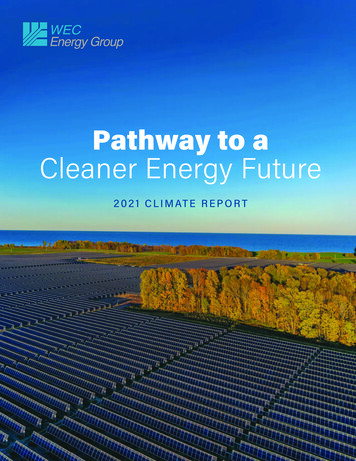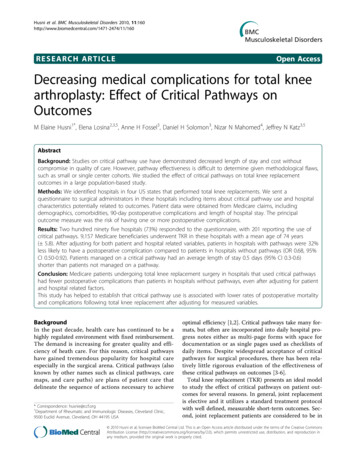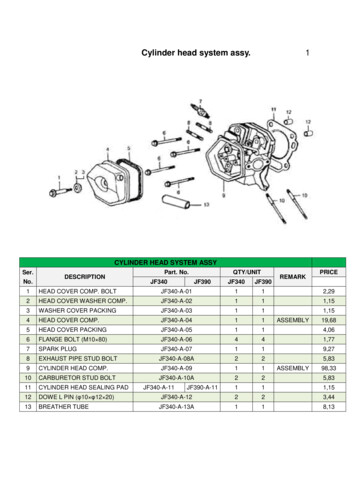
Transcription
Pathway to aCleaner Energy Future2 0 2 1 C L I M AT E R E P O R T
Gale KlappaExecutive ChairmanKevin FletcherPresident andChief Executive OfficerMessage fromCompany LeadershipIn 2019, we published our first climate report — covering climate-related riskmanagement, governance and analyses of potential pathways for carbon reduction.We outlined our goals and described opportunities to invest in a clean energy future.In the two years since that report, we have found new opportunities for sustainablegrowth and made great progress in transforming our electric generation fleet — somuch so that we have set new, industry-leading targets for lower emissions.Where We Stand: Where We’re Headed.By the end of 2020, we were able to reduce carbon dioxide emissions morethan 50 percent below 2005 levels.By making operating refinements, retiring less efficient generating units, andexecuting our capital plan, we are committing to a 60 percent reduction incarbon emissions by 2025 and an 80 percent reduction by the end of 2030.Over the longer term, the target for our generation fleet is net-zero carbonemissions by 2050.In addition, we continue to reduce methane emissions by improving our naturalgas distribution system. Our initial 2030 goal called for a 30 percent reduction inmethane emissions from a 2011 baseline. Given advancements with renewablenatural gas and the advantages that come with serving America’s Dairyland, weare setting a new target across our natural gas distribution operations to achievenet-zero methane emissions by the end of 2030.In setting these aggressive targets, we are keeping customer affordability andreliability at the forefront of our mission. Throughout the following pages, you willfind more details on our planning and risk management, grounded, as always, inthorough research and analysis.
We are committing to a 60 percentreduction in carbon emissions by2025 and an 80 percent reductionby the end of 2030.We believe we can achieve our 2025 and 2030 goals without anynew technological developments. Our current capital plan putsus on track, as we expect to retire approximately 1,800 megawattsof older, fossil-fueled generating capacity. By 2025, that capacitywill be replaced by zero-carbon-emitting renewables and cleannatural gas-fueled generation. The affordability and efficiency ofwind and solar energy, as well as battery storage, have improvedrapidly in recent years, making renewable investments beneficialto both the environment and our customers. Our capital planalso supports needed improvements in natural gas infrastructurethrough our System Modernization Program, which is significantlyreducing methane emissions in Chicago.Looking beyond 2030, our ability to achieve net-zero carbon willdepend on a variety of factors — regulatory, economic, technological,to name a few. We see considerable potential for innovation inenergy storage, carbon capture and other technologies, especiallywith the support of public policy.Our mission is clear. Deliver energy that is affordable, reliable,and clean. Energy our customers can depend on — today andthroughout the transition to a low-carbon future.Gale E. KlappaExecutive ChairmanJ. Kevin FletcherPresident and Chief Executive OfficerMaintaining reliabilitywhile advancingclimate strategyService reliability and resiliencyremain paramount as we workto transition to a net-zero carbongenerating fleet. Over the lastdecade, we have maintainedaward-winning electric reliabilitywhile reducing our greenhousegas intensity. At the same time,cases of extreme weatherin our service area — andrecent widespread outages inTexas — have demonstratedthe imperative of resilientinfrastructure and a diversegeneration mix. As we work tointegrate renewable resourcesand pursue greater climateaction, we will continue tomanage risks across our systemwhile at the same time investingin modern infrastructure.May 4, 20211
An energy industry leaderWEC Energy Group is one of the nation’s leading energy companies,with the operational expertise and financial resources to meet the needsof 4.6 million customers across the Midwest.WEC Energy Group by the numbersas of Dec. 31. 2020 29.0 billionmarket cap1.6 millionelectric customers3.0 millionnatural gas customers60% ownership7,700 megawatts71,000 miles 22.8 billionof American Transmission Co.of electric distribution51,400 milesof natural gas distributionand transmissionof power capacityof asset base98%regulatedOur subsidiaries focus on delivering safe and reliable energy with a commitment to customersatisfaction. Together, we provide energy services to customers throughout Wisconsin, Illinois,Michigan and Minnesota. We understand that our energy infrastructure must be designed not onlyto endure but also to support the environment and our region's economy.2PATHWAY TO A CLEANER ENERGY FUTURE
Executive summaryThis updated report illustrates the approach we are taking toreduce greenhouse gas (GHG) emissions and presents an analysisof factors that could affect our future decision-making. It wasprepared in collaboration with M.J. Bradley & Associates (MJB&A)and reflects previous research and input from the Electric PowerResearch Institute (EPRI).MJB&A, an ERM Group company, is known for analytical expertise andstrategic consulting services to address energy and environmentalissues. The organization engages with a variety of stakeholder groups,combining private sector strategy with public policy in energy,climate change, energy efficiency, renewable energy and advancedtechnologies.EPRI is a nonprofit, scientific research organization with a publicbenefit mandate. For many years, EPRI has demonstrated technicalcapabilities in assessing and modeling potential futures, identifyingkey assumptions, capturing and quantifying uncertainties, andengaging subject matter experts from many diverse, climate-relatedfields. Due to its work as lead authors for the IntergovernmentalPanel on Climate Change, EPRI offers unique perspectives on globalclimate matters. EPRI research and modeling were key to our initialassessment of potential transitions through 2050, published in our2019 climate report.The TCFD recommendations guidethe structure of this report: Governance (Page 4) In this section, we describe how our governancestructure supports and provides oversight for ourshort- and long-term corporate strategy. Business and climate strategy (Page 6) This section describes the actual and potentialimpacts of climate-related risks and opportunitieson our businesses, strategy and financial planning,informed by climate scenario analyses. Risk management (Page 22) This section outlines the processes we use toidentify, assess and manage climate-related risks. Metrics and targets (Page 25) In this section, we provide an overview of ourgoals for managing GHG emissions andinformation on our environmental assessmentsand reporting.Our report follows the recommendations of the Financial StabilityBoard’s Task Force on Climate-Related Financial Disclosures (TCFD).TCFD suggests a logical method for framing climate issues, startingwith general strategies and moving to specific tactics, whileencouraging transparency and organizational engagement. Usingthis framework enables interested parties to compare our results toother reporting entities.Addressing climatechange is an integralcomponent of ourstrategy, which we arecommitted to achievewhile we also fulfill ourobligation to providereliable, affordableenergy to customers.PATHWAY TO A CLEANER ENERGY FUTUREThe analysis in this report supports our current emissions reductiontrajectory, while demonstrating the importance of technologicaland market innovation in the years ahead. We see the potential foreconomywide emissions reduction through electrification, which ourelectric companies could help facilitate.Recent and planned investments in renewable energy, air qualitycontrol systems, power grid upgrades, natural gas distributionsystem modernization and other environmental protectiontechnologies position WEC Energy Group well for the future.3
GovernanceBoard of directors Provides oversight of company’smajor strategic initiatives —including GHG goal-setting —and overall risk environment Delegates certain duties andrisk-monitoring activities toboard committees Retains oversight responsibilityof risks that have the potentialto result in significant financial,operational or reputationalconsequences, including potentialimpacts of climate changeBoard committees Maintain four standingcommittees that meet regularly— Audit and Oversight,Compensation, CorporateGovernance, Finance; conveneExecutive Committee as needed Receive regular managementand outside adviser briefingson specific areas of current andemerging risks pertinent to eachcommittee’s charter Report committee findings tofull boardManagement Designs and operates riskmanagement program, includingrisk identification, assessmentand prioritization Conducts regular, executive-levelcommittee review of key riskareas, including those related toclimate change Engages with board andcommittee chairs on areas ofassigned risk oversight4Our governance structure drives corporate accountability and issupported by policies and management systems to anticipate, planfor and manage corporate initiatives and risks, including thoserelated to climate change. We believe that effective corporategovernance is an essential driver of stockholder value and a keycomponent of sustainability.Our board of directors is responsible for providing oversight with respect to our majorstrategic initiatives — including GHG goal-setting and execution thereof — whichrequires meaningful dialogue with our senior management team about opportunitiesand risks, analysis of scenarios and strategies that flow therefrom, and the processesthrough which senior management maintains focus on the organization’s key financialand business objectives, corporate policies, and overall economic, environmental andsocial performance. Senior management, in turn, is responsible for effective planningand execution of daily operations. Success requires a cohesive system for timelyidentification and evaluation of relevant information.Oversight by the board of directorsOur board of directors fulfills its oversight responsibilities through sound principles thatalign with governance best practices. Each director is elected annually using a one-share,one-vote, majority-vote standard in uncontested elections. Our Corporate GovernanceGuidelines provide that the board will consist of at least a two-thirds majority of independentdirectors at all times. Current board members possess a diversity of knowledge and skills,including expertise in the utility industry and on environmental, social and governance topics.Our board of directors oversees the company’s risk environment and associatedmanagement practices as part of its evaluation of the company’s ongoing operationsand strategic direction. To carry out its oversight function, the board is organized intofive standing committees with specific duties and risk-monitoring responsibilities:Audit and Oversight, Compensation, Corporate Governance, Executive, and Finance.With the exception of the Executive Committee, the board and each of its committees meetregularly throughout the year, and receive regular briefings prepared by management andoutside advisers on specific areas of current and emerging risks to the enterprise. Thecommittees routinely report to the full board on matters that fall within designated areas ofresponsibility as described in their charters.For example, the Audit and Oversight Committee assists the board in overseeing legaland regulatory compliance, including matters pertaining to environmental, litigation,and ethics and compliance programs; electric reliability standards compliance; anddata privacy and security including cyber, physical and operating technology. Withrespect to environmental matters, the company’s vice president — environmentalprovides the committee with regular reports throughout the year that highlightsignificant regulatory and compliance activities, as well as updates on initiatives aimedat achieving company priorities, including the reduction of GHG emissions.While the board delegates specified duties to its committees, the board retainscollective responsibility for comprehensive risk oversight, including short- and longterm critical risks that could impact the company’s sustainability. The board believesthat certain matters must be contemplated principally by the diverse perspective ofits full membership. This includes oversight of risks that have the potential to result inPATHWAY TO A CLEANER ENERGY FUTURE
GrowthInvesting 16.1billion 3.019%Sustainability 4.1 Renewables 6.3 Grid and fleetreliabilitybetween 2021-2025 10.464%(in billions)significant financial or reputational consequences, such as thepossible impact of climate change on the utility sector, and reviewand approval of significant capital projects and investments,such as those that will enable the company to meet its emissionsreduction goals.Throughout the year, the board engages in substantive discussionswith management about the company’s long-term strategy. Factoredinto its oversight responsibilities, the board must include within itsevaluation an understanding of the primary mandates of an investorowned utility and the many risks and opportunities broadly facingthe utility sector, including opportunities and risks related to climatechange. Management routinely reports to the board on both highlevel and narrowly focused risks, which serve as important input asthe directors evaluate the range and impact of strategic alternatives.Management also provides significant educational opportunitiesfor the board to better understand the external environment withinwhich the company operates, including briefings and presentationsprovided by outside advisers, large institutional investors and otherstakeholders. In addition, the full board reviews the company’sCorporate Responsibility Report each year before it is publishedto verify that it appropriately communicates the company’s view ofcorporate citizenship, including environmental stewardship.Support for strategic objectivesManagement regularly updates the board on its capital spendingplans, which underpin the company’s most significant strategicobjectives and are prepared in five-year increments, and refreshedannually with the board’s oversight.Beginning in October 2020, management reviewed with the boardits “ESG Progress Plan: A Road Map for Investment in Efficiency,Sustainability and Growth,” the company’s five-year (2021-2025), 16.1 billion capital plan. Management and the board engaged inlengthy discussions on the rationale for the proposed 16.1 billionin investments over five years, which are designed to help thePATHWAY TO A CLEANER ENERGY FUTURE 2.717% 1.6 Gas distribution 1.4 Electric generation,transmission and distributionEfficiency 1.0 Technology 1.7 Grid and fleetmodernizationcompany achieve its long-term emissions reduction targets.Management and the board discussed the underlying businessneed for the plan, regulatory environment, the plan’s financialimplications and the technological advancements that will beneeded to achieve the company’s long-term goals, includingnet-zero carbon emissions from its electric generation by 2050.An important aspect of the board’s oversight responsibilities is tohold the executive management team accountable for achievingthe company’s goals and objectives. This includes oversight ofexecutive compensation. The board’s Compensation Committeehas a long track record of providing an executive compensationprogram that incentivizes the achievement of both the company’slong-term strategies and short-term objectives.Delivering a cleaner energy future is one of the fundamentals of ourbusiness and a major focus of our capital plan. The CompensationCommittee assesses management’s performance in achievingthe tenets of the company’s long-term strategic sustainabilitygoals through the execution of its capital spending plan, whichis composed of multiyear projects tied to strategic objectives.Management annually refreshes the capital plan, which includesa preview of anticipated capital spending over five years, anddiscloses it publicly during the fourth quarter each year. As notedabove, the company’s ESG Progress Plan details significantinvestments in low- and no-carbon generation and modernizationof its natural gas infrastructure, actions that are specifically aimedat helping to reduce the emission of GHGs (carbon and methane).The company’s ability to fund this substantial capital plan withoutissuing additional equity has been directly linked with the company’sability to consistently deliver on its financial plan, including meetingthe financial metrics used in the company’s compensation program.These financial measures are key performance indicators underlyingour executives’ incentive compensation, thus linking management’spathway to achieving our long-term strategy through its focus onshort-term priorities.5
Business and climate strategyWe are committed to ensuring customers havethe energy they need and that we operate in anenvironmentally responsible manner, makingrenewable energy a key part of our energy mix.Our commitment to addressing climate change isexemplified in our ambitious goal to become netcarbon neutral by 2050.Climate change has become an integral part of our businessstrategy. A priority sustainability issue assessment, completed in2020, highlighted its continuing importance to our business andour stakeholders. Building on our 2019 Climate Report and itsscenario analyses, through which we assessed the strengths andweaknesses of our strategy, we continue to evaluate physical andtransition risks and opportunities presented by GHG emissionsmanagement and climate adaptation.Based on our assessments, and in support of our GHG goals, weare transforming our portfolio of electric generation facilitiesand modernizing our infrastructure to improve environmentalperformance. As we continue to reduce our environmental footprint,we are committed to maintaining the affordability, reliability andresiliency that are the cornerstones of our business model.Electric generationreduction goals60%below 2005levels2025Natural gas distributionreduction goal6Our role in transitioning to a low-carbon economy goes well beyondour own system. As a utility company, we have a responsibilityto provide affordable and sustainable energy that will power ourcustomers' homes, businesses and motor vehicles, facilitatingemissions reduction throughout the economy. We have integratedthat responsibility further into our planning and operations bysetting aggressive goals for emissions reduction.In 2019, over a decade early, we achieved our initial goal to reduceCO2 emissions 40% below 2005 levels by 2030. That is why, in 2020,we re-evaluated our portfolio and set an ambitious goal for ourelectric generation fleet to be net carbon neutral by 2050. Our priorlong-term goal was to reduce our CO2 emissions 80% below 2005levels by 2050. To ensure we remain on track to meet our new longterm goal, we have also set interim targets to reduce CO2 emissionsby 60% by 2025 and 80% by 2030, both below 2005 levels. Weare well on our way to achieving these targets and will continue toreport on our progress.In addition, for our natural gas delivery operations, we have set atarget of net-zero methane emissions by 2030. We adopted thismore ambitious goal in light of ongoing infrastructure improvementsand the potential benefits of renewable natural gas.Demonstrating our commitment to progress, we expect to investmore than 16 billion across our company between 2021 and 2025 —reducing our GHG emissions, maintaining superior reliability, loweringoperating costs and growing our investment in the future of energy.80%below 2005levelsNet carbonneutral20302050Net-zero methaneemissionsPATHWAY TO A CLEANER ENERGY FUTURE
An evolving business modelOur coal-based revenue declined 43% between 2017 and 2020.We expect the percentage of our revenue and asset base that istied to coal will be less than 10% at the end of 2025.2020 assets by business typeRenewablesNatural gas generationElectric transmission*11%Natural tribution25%2020 revenue contribution by sourceNatural icdistribution her* ATC is accounted for using the equity method; this representsWEC Energy Group's portion of the asset base.** Includes purchased power.*** Represents transmission expense that we are authorized to collect in rates.PATHWAY TO A CLEANER ENERGY FUTURE7
Our stockholders and customers have made it clear that together wemust transition to a low-carbon future. Through our actions, we willnot only deliver cleaner energy to our customers, but also fortify andmodernize our electricity grid and distribution services.Our goalContinue to build and sustain long-term value for our stockholders and customersby focusing on the fundamentals of our business: safety, reliability, operatingefficiency, financial discipline, customer care and environmental stewardship.Our approachWe remain focused on delivering exceptional customer care every day.We strive to provide the best value for our customers by embracingconstructive change, demonstrating personal responsibility for results,leveraging our capabilities and expertise, and using creative solutions tomeet or exceed our customers’ expectations.8PATHWAY TO A CLEANER ENERGY FUTURE
Electricity generation supplyAs our generation mix continues to evolve, we will focuson maintaining the fuel diversity needed to producereliable, safe and affordable power while reducing ourcarbon footprint.We supply energy to our utility customers from generation facilities we own,representing approximately 7,700 megawatts (MW) of power capacity in 2020,and purchased power. Power purchases represent about one-third of theelectricity we deliver, and approximately two-thirds of that purchased powercomes from zero-carbon sources (e.g., renewables and nuclear). We expectpurchased power from the Point Beach Nuclear Plant to supply 20% of theelectricity we provide to our utility customers over the next decade. In addition,through our WEC Infrastructure subsidiary, we own majority shares in windfarms outside our traditional footprint.In pursuit of our goal to achieve a carbon neutral generating fleet by 2050, weare evaluating a range of approaches and investments that will help to reduceand mitigate our GHG emissions. As part of our climate strategy, we havedramatically reduced our reliance on coal-fueled generation since 2005. We havebuilt cost-effective, state-of-the-art natural gas-fueled generation and zero-carbongeneration. Since 2018, we have retired more than 1,800 MW of nameplate coalcapacity. These retirements have lowered operating costs by approximately 100 million on an annual basis and eliminated more than 10 million tons of CO2emissions per year from these sources.Electricity supply by fuel type(megawatt-hours delivered to regulatedutility customers)200573%17%7%Coal36%(as of Dec. 31, 2020)NuclearRenewables36%22%6%CoalNatural gasNuclearRenewables2030 estimatedThe following table lists the utility and non-utility renewable energy assets inour portfolio.Capacity (MW)1Natural gas2020Renewable energy portfolioFacilities3%Serving30 hydroelectric plants100Utility customers1 biomass plant45Utility customers5 wind turbine facilities498Utility customers1 solar facility100Utility customers5 wind turbine facilities8362InfrastructurecustomersTotal renewable capacity1,57939%29%24%8%CoalNatural gasNuclearRenewables2050 estimatedNet carbon neutral1 I n line with our reports to the Securities and Exchange Commission, this table uses nameplatecapacity for our solar and wind facilities, and rated capacity for other energy sources.2 Includes total nameplate capacity of jointly owned infrastructure wind projects.PATHWAY TO A CLEANER ENERGY FUTURE9
WEC Infrastructure wind facilitiesIn serviceUnder developmentRecent opportunities to invest in energy infrastructure outside of our regulated utilities have helpedour business grow in a sustainable way. We have committed 2.2 billion in our 2021-2025 capitalexpenditure plan to increase renewable energy generation in the Midwest. This investmentwill build upon the 1.2 billion that WEC Infrastructure invested through 2020 in wind farmdevelopment. We have acquired or agreed to acquire majority interests in seven wind farms acrossIllinois, Kansas, Nebraska and South Dakota. Together, these resources are capable of providing over1,300 MW of carbon-free energy and represent long-term agreements to serve investment-gradecustomers outside our traditional service areas.10PATHWAY TO A CLEANER ENERGY FUTURE
ESG Progress PlanLong-term outlookAs part of our five-year capital plan, we expect to retire approximately1,800 MW of nameplate fossil-fueled generating capacity between2021 and 2025, providing further economic and environmentaladvantages. Included in these planned retirements are 1,100 MWfrom Oak Creek Power Plant, approximately 300 MW from ourowned portion of Columbia Energy Center, and 400 MW of oldernatural gas-fueled generation.We will continue to replace fossil generating facilities with carbon-freeor lower-carbon natural gas resources, including additional wind,solar and other renewable energy technologies. The pace of thesefossil plant retirements and new plant construction will be guided byreliability and cost considerations, and public policy decisions couldalso influence our decision-making. Additional transmission systeminvestments and energy storage projects may also be required tosupport these developments. Potential transmission system expansionwill be a key factor in our capital planning.As our generation mix continues to evolve, we will be increasingour investments in zero-carbon resources. By 2025, we plan toinvest 1.9 billion to increase the amount of renewable generationin our Wisconsin utility system through our regulated utilities andanother 2.2 billion through our WEC Infrastructure subsidiary.Renewable investmentsrepresent approximately25% of our plannedcapital spending from2021 through 2025.These utility investments will add 1,800 MW of renewable capacityto our portfolio. Included in this are plans to build 600 MW of batterystorage to balance intermittent renewable resources and meetpeak energy demand. In early 2021, we filed with the Public ServiceCommission of Wisconsin for approval to take major steps towardthis goal: building two new solar and battery storage projects inWisconsin by 2023. If approved, the facilities will feature, in total,450 MW of solar generation and 185 MW of battery storage, witha four-hour duration, to provide “sunshine after sunset.”The costs of renewable technology and battery storage havedropped drastically in recent years, making projects like thiscost-effective for our customers.In addition, to help replace older, less efficient fossil-fueled powerplants, we plan to build 100 MW of natural gas-fueled, reciprocatinginternal combustion engine peaking plants, and we have an optionto purchase a 200 MW share of the West Riverside natural gas plant.These flexible resources are critical for maintaining reliable serviceas we integrate additional renewable resources into the grid.PATHWAY TO A CLEANER ENERGY FUTUREOur newer, more efficient coal units continue to play an importantrole in ensuring the reliable service our utilities must provide. Theyare able to be dispatched during extreme weather conditions,when natural gas supply lines or renewable technology may becompromised. Elm Road units 1 and 2 are among the newest andmost efficient coal-fueled generating units in the United States,having begun commercial operation in 2010 and 2011, respectively.We have an approximately 85% ownership interest in the two units.Weston 4, in which we have a 70% ownership interest, is also a newcoal plant; commercial operation began in 2008. As relatively newcoal units, these would be potential candidates for carbon capture,utilization and storage (CCUS) after 2030, assuming the technologyis further developed. Nature-based offsets (e.g., tree planting) andagricultural offsets could also be potential options to address thelimited emissions from our remaining coal units.We are also considering options to address any remaining emissionsfrom our natural gas-fueled power plants, combined-cycle facilities,combustion turbines and reciprocating engines. In 2020, we joinedthe Low-Carbon Resources Initiative (LCRI), a joint partnershipbetween EPRI and Gas Technology Institute (GTI), which will focuson large-scale deployment of low-carbon technologies.The five-year initiative will:1. Identify and accelerate development of promisingtechnologies, including hydrogen, bioenergy, CCUS andrenewable natural gas.2. Demonstrate and assess the performance of keytechnologies and processes and identify possibleimprovements.3. Inform key stakeholders and the public about technologyoptions and potential pathways to a low-carbon future.This research and development effort will help to inform our longerterm strategy to address the emissions from our natural gas-fueledpower plants.11
Reaching net-zero power generation2020-20302030-20402040 New carbon-free resourcesWind, solar and othercarbon-free resources willbe a major area of investmentfor WEC Energy Group and itssubsidiaries over the comingdecades.plus-circle 100 MW of utility windplus-circle 1,100 MW of solarContinuing investments in wind, solarand other carbon-free resourcesplus-circle 2.2 billion of investment inWEC Infrastructure wind between2021 and 2025plus-circle Further renewable additionsbetween 2026 and 2030Flexible resourcesDispat
Over the longer term, the target for our generation fleet is net-zero carbon emissions by 2050. In addition, we continue to reduce methane emissions by improving our natural gas distribution system. Our initial 2030 goal called for a 30 percent reduction in methane emissions from a 2011 baseline. Given advancements with renewable











